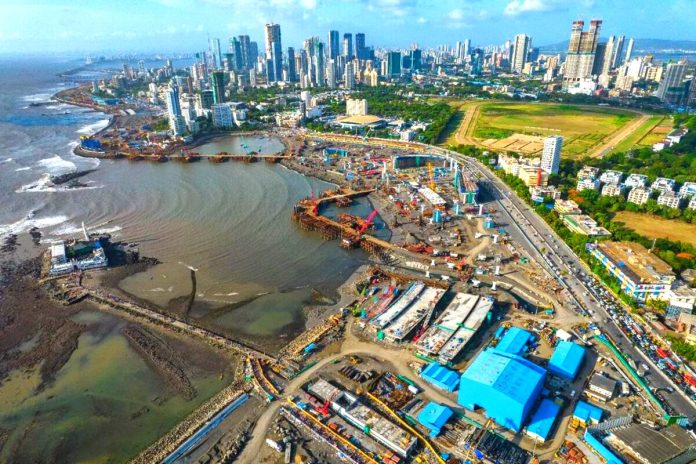Mumbai is on the brink of a major infrastructure overhaul, with the Mumbai Metropolitan Region Development Authority (MMRDA) unveiling an ambitious Ring Road masterplan designed to revolutionize urban mobility.
This mega-project, which spans across the Mumbai Metropolitan Region (MMR), aims to eliminate the city’s notorious traffic bottlenecks by 2029, offering a glimpse of a faster, more efficient future for commuters.
The Ring Road network is poised to connect North Mumbai, near the Gujarat border, to Alibaug in the south, while also linking key regions like Navi Mumbai and Thane. The project covers an extensive network of new roads, flyovers, coastal roads, bridges, and tunnels, including underwater passages. Once complete, it promises to decongest Mumbai’s roads and dramatically reduce travel times, providing a smooth, signal-free journey across the region.
The Ring Road masterplan, estimated to cost Rs 58,517 crore for road development alone, is part of a larger Rs 3 lakh crore infrastructure package that includes metro lines, bridges, and slum redevelopment projects.
The MMRDA is leading this effort alongside other major agencies like the Brihanmumbai Municipal Corporation (BMC) and the Maharashtra State Road Development Corporation (MSRDC). Together, these bodies aim to create a seamless road network that will ensure fast, uninterrupted travel from one end of the city to the other.
One of the major objectives of the Ring Road network is to improve east-west connectivity, which has historically been underdeveloped in Mumbai. Traditionally, most of the city’s infrastructure has focused on north-south routes, which has left east-west corridors congested and inefficient. The new road network seeks to address this imbalance and streamline traffic flow across the entire metropolitan region.
The Vision: Decongesting Mumbai By 2029
Once complete, the Ring Road system will comprise multiple interconnected roads encircling Mumbai, creating a loop that connects key areas and highways.
The first Ring Road, for example, will start at Nariman Point, following the Mumbai Coastal Road, and then connect to the Bandra-Worli Sea Link. From there, it will link with the Sewri-Worli Connector, the Eastern Freeway, and the proposed Orange Gate Tunnel, eventually looping back to Nariman Point.
This initial loop is just one part of the larger masterplan. A total of six major Ring Roads are planned, each incorporating both existing and newly developed roads. These include the Bandra-Worli Sea Link, the Western Express Highway, the Eastern Express Highway, and several under-construction routes like the Versova-Dahisar Link Road and the Goregaon-Mulund Link Road, according to Indian Express.
Boosting Economic Growth
Mumbai currently contributes around 4 per cent of India’s GDP (gross domestic product), and experts believe that the city’s contribution could double in the coming decade, driven in part by improved infrastructure.
According to a report by NITI Aayog, the GDP of the Mumbai Metropolitan Region could surge from 140𝑏𝑖𝑙𝑙𝑖𝑜𝑛𝑡𝑜300 billion by 2030. The Ring Road project is expected to play a crucial role in this economic expansion by improving access to business hubs and easing the transportation of goods and services across the region.
The improved connectivity will also have a significant impact on real estate, as faster travel times make previously inaccessible or underdeveloped areas more attractive for both residential and commercial investments. Suburbs like Thane, Navi Mumbai, and areas in the eastern parts of the city are likely to see increased interest from developers, creating new opportunities for growth.
Public Transport Integration
The Ring Road masterplan isn’t solely focused on car traffic. The plan is closely linked with other major public transport projects, including new metro lines, dedicated bus lanes, and flyovers. This integrated approach is expected to make public transportation more reliable and efficient, reducing the dependence on private vehicles and alleviating pressure on the existing local train and road networks.
The construction of these new roads and tunnels will also encourage greater use of public transport, as smoother and faster routes incentivize commuters to shift away from private cars. The upcoming metro lines, which are being developed in parallel with the road network, will serve as a critical backbone for public transport, offering an alternative to the congested roads.
Coordination And Challenges
While the Ring Road masterplan is an ambitious and promising project, it is not without its challenges. Coordination between multiple agencies, including the MMRDA, BMC, and MSRDC, will be crucial to the project’s success. Delays in one part of the project could potentially slow down the entire plan, making it essential that these agencies work in sync to ensure timely completion.
Additionally, environmental concerns have emerged as a significant challenge. The project involves the construction of roads through ecologically sensitive areas, including coastal regions and mangroves. Activists and environmental groups have raised concerns about the potential impact on the environment, particularly in areas where land reclamation is necessary to build new roads or tunnels.
The Ring Road project represents a bold vision for the future of Mumbai’s transportation network. By 2029, if everything goes according to plan, the city could see a drastic reduction in congestion and travel times, with a comprehensive, interconnected road system making it easier for residents and commuters to move from one part of the city to another.
As MMRDA Commissioner Sanjay Mukherjee emphasized, the ultimate goal is to reduce travel time across Mumbai to under an hour. “When we say Mumbai in minutes, it should not take more than 59 minutes to travel from one end of the city to the other,” he stated.
If successful, this project will not only ease the daily commute for millions but also stimulate economic growth and improve the quality of life for Mumbai’s residents. With better infrastructure, the city could enter a new era of growth and prosperity, positioning itself as a modern metropolis capable of meeting the demands of its ever-growing population.


